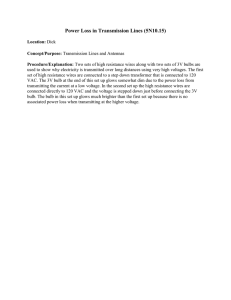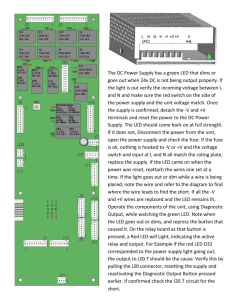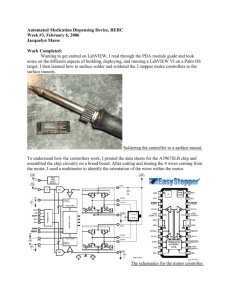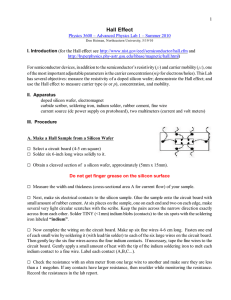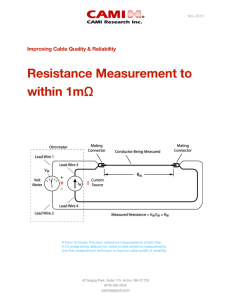Temperature Coefficient of Resistivity
advertisement
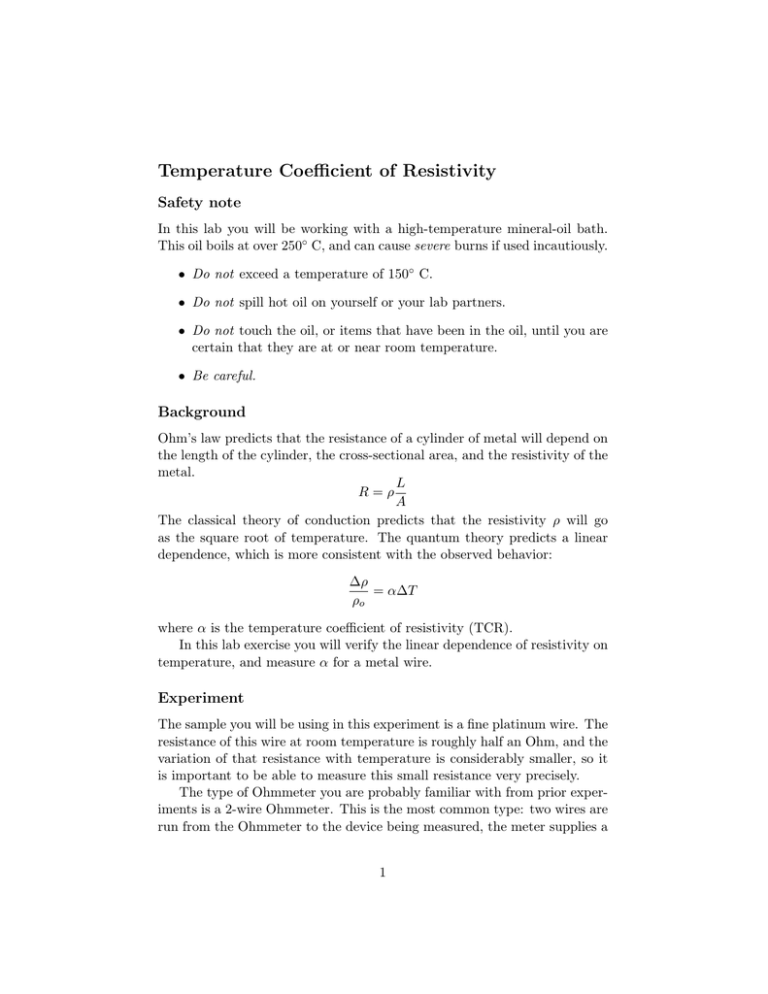
Temperature Coefficient of Resistivity Safety note In this lab you will be working with a high-temperature mineral-oil bath. This oil boils at over 250◦ C, and can cause severe burns if used incautiously. • Do not exceed a temperature of 150◦ C. • Do not spill hot oil on yourself or your lab partners. • Do not touch the oil, or items that have been in the oil, until you are certain that they are at or near room temperature. • Be careful. Background Ohm’s law predicts that the resistance of a cylinder of metal will depend on the length of the cylinder, the cross-sectional area, and the resistivity of the metal. L R=ρ A The classical theory of conduction predicts that the resistivity ρ will go as the square root of temperature. The quantum theory predicts a linear dependence, which is more consistent with the observed behavior: ∆ρ = α∆T ρo where α is the temperature coefficient of resistivity (TCR). In this lab exercise you will verify the linear dependence of resistivity on temperature, and measure α for a metal wire. Experiment The sample you will be using in this experiment is a fine platinum wire. The resistance of this wire at room temperature is roughly half an Ohm, and the variation of that resistance with temperature is considerably smaller, so it is important to be able to measure this small resistance very precisely. The type of Ohmmeter you are probably familiar with from prior experiments is a 2-wire Ohmmeter. This is the most common type: two wires are run from the Ohmmeter to the device being measured, the meter supplies a 1 known current through the wires and device, and measures the voltage drop across the terminals. The meter then divides the measured voltage by the current to obtain the resistance. The disadvantage of a 2-wire measurement is that any voltage drop across the wires (Vwire = IRwire ) is incorrectly attributed to the device being measured. The resistance of most hook-up wires is a bit less than an Ohm. This extra Ohm or two makes little difference when you’re measuring typical components, but it becomes rather difficult to measure mΩ changes in resistance when the resistance of your hook-up wires is a thousand times larger than your measurement changes. The solution is to use a 4-wire measurement. Two wires supply the current, and the other two are used to measure the voltage. There is still a voltage drop across the current wires, but a voltmeter takes so little current (ideally zero) that there is no significant voltage drop across the voltage sensing wires. This eliminates any dependence on the characteristics of the wiring. They can have high resistance —or even changing resistance— and it makes no difference as far as the resistance measurement is concerned. Procedure 1. The platinum wire sample has been prepared in advance. Carefully observe the connections at the working end, and connect the banana plugs to the 4-wire multimeter appropriately. Set the meter to 4-wire resistance measurements. A second sample has also been prepared for you. This sample has a much higher resistance, and the resistance changes quite a bit with temperature, so a regular 2-wire resistance measurement is adequate. 2. Place both samples, and the LM335 thermometer, in the mineral-oil bath on the hot plate. Make sure the magnetic stirrer is working properly. 3. Gradually raise the temperature, and record the resistance for a wide range of temperatures (Use C◦ for temperature measurements.) You will probably want to set up LabView to do this for you — see the following section for details. 4. Plot resistance vs. temperature for the platinum wire. Does it follow the classical or the quantum model? What is the TCR for your platinum wire? How does your measured TCR compare with the accepted value? 2 5. Plot resistance vs. temperature for the second sample. What can you say about this sample? Controlling this experiment via computer Most high-quality measurement instruments (including the Keithley meters we are using for this experiment) can be computer-controlled through a USB or GPIB1 connection. The thermometer we are using for this experiment just generates a voltage, so its output can be read by a computer interface also. This means that this experiment is ideal for LabView control. There are three sample files in the shared documents/LabView folder on the computer: 2000-read.vi, 2700-read.vi, 2100-read.vi. These three should be sufficient to get you started on a LabView program to automatically take data from the Keithley meters. 1. Set up a ‘while’ loop in Labview that takes data readings every 10 seconds or so. Remember to include a ‘stop’ button in the loop. 2. Use code similar to these examples to read the two resistance measurements and the temperature, once per loop. Note that the initialization and measurement-selection portions of the sample programs only have to be done once, so you will probably want these bits of code to be outside of the loop. 3. Have the program exit the loop and save the data to a spreadsheetreadable file when the ‘stop’ button is pressed. 4. It’s relatively easy to do other fancy stuff in LabView, which may or may not be useful. Examples might include graphing the data as it’s collected, setting off flashing lights and sirens when the temperature exceeds 150◦ C, etc. While impressive, these are not actually physics. They are optional. 1 General-Purpose Interface Bus 3

